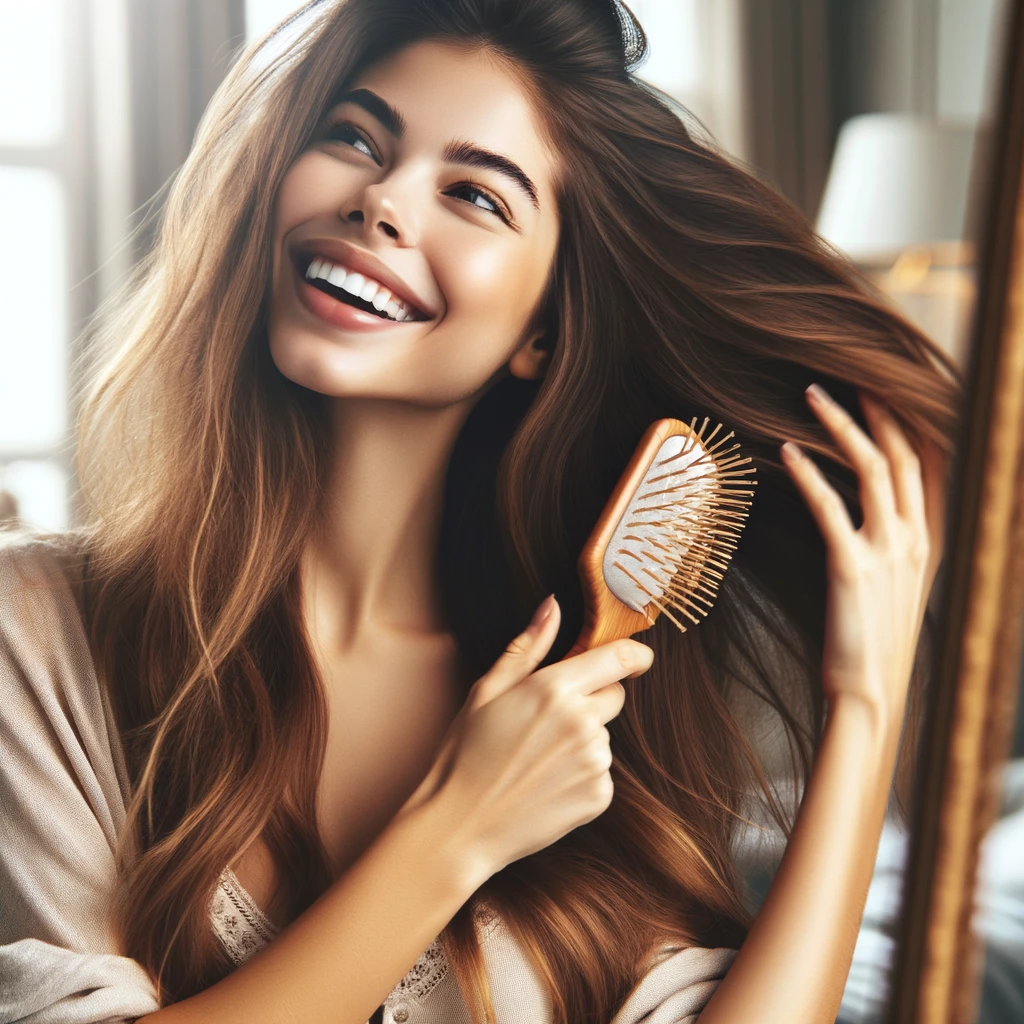Entendiendo la rotura del cabello: causas y prevención

In this article:
In this guide we will help you understand hair breakage, often referred to as brittle hair. We'll explore what causes your locks to lose their strengt, which types of hair are most at risk, and, most importantly, how you can fix and prevent it.
What is Hair Breakage?
Hair breakage (or brittle hair) is a common condition where strands become fragile and snap off more quickly than usual. This issue can make hair look frizzy, dull, and thin, affecting its health and appearance. But what exactly is hair breakage, and how does it differ from hair loss? Let's break it down
Hair Breakage vs Hair Loss
- Hair Breakage: This condition involves breaking hair strands from any part of the hair shaft, not necessarily from the root. It does not affect the hair follicle itself. Brittle hair often looks dull and feels dry to the touch. It may also have split ends and a rough texture, making it difficult to manage.
- Hair Loss: In contrast, hair loss refers to hair shedding from the root. You can identify this by a small white bulb at the end of the fallen hair strand.

What Causes Hair Breakage
Dryness
- Dryness: Lack of moisture can make hair brittle and prone to breaking.
- Solution: Hydrate your hair with deep conditioning treatments and use leave-in conditioners.
Improper Towel Drying
- Key Cause: Rubbing your hair with a towel can cause friction and breakage.
- Solution: Gently blot your hair with a towel instead of rubbing.
Low-Quality Hair Care Products
- Key Cause: Harsh chemicals in some products can weaken your hair.
- Solution: Opt for sulfate-free shampoos and conditioners with natural ingredients.
Wrong Brushing Techniques
- Key Cause: Brushing too hard or using the wrong brush can tear hair.
- Solution: Use a wide-tooth comb or a soft-bristle brush, especially when hair is wet.
Excessive Coloring and Bleaching
- Key Cause: Chemical treatments can strip hair of its natural oils.
- Solution: Limit chemical treatments and use color-protective products.
Skipping Conditioner
- Key Cause: Not using conditioner leaves hair unprotected
- Solution: Always use a conditioner after shampooing to add moisture and protection.
Not Getting Regular Trims
- Key Cause: Split ends make hair weak can lead to further breakage.
- Solution: Trim your hair every 6-8 weeks to prevent split ends from worsening.
Tight Hairstyles
- Key Cause: Styles that pull on the hair can cause breakage at the root.
- Solution: Wear looser hairstyles to reduce tension on your hair.
Diet and Stress
- Key Cause: Poor nutrition and high stress can weaken hair.
- Solution: Eat a balanced diet rich in vitamins and minerals, and manage stress through relaxation techniques.
Heat Damage
- Key Cause: Using hot styling tools without protection.
- Solution: Use a heat protectant spray and limit the use of hot tools.
Environmental Factors
- Key Cause: Sun exposure, wind, and pollution can damage hair.
- Solution: Protect your hair with hats and use UV-protective sprays.
Over-processing
- Key Cause: Too much chemical treatment.
- Solution: Give your hair a break from treatments and use restorative masks.
Which Hair Type is Prone to Hair Breakage?
Every hair type has unique characteristics, making some more prone to breakage than others. Understanding your hair type is crucial in adopting the proper care strategies to minimize damage.
Curly Hair
- Prone to Dryness: Curly hair naturally tends to be drier than straight hair, making it more vulnerable to breakage.
- Care Tips: Moisturize regularly with deep conditioners and leave-in treatments. Avoid brushing when dry; instead, detangle gently when wet with a wide-tooth comb.
Straight Hair
- Oil Distribution: Straight hair allows for easier distribution of natural oils from the scalp, which can protect against breakage but may lead to oiliness.
- Care Tips: Use lightweight, hydrating products that don't weigh hair down. Avoid overwashing to prevent dryness.
Fine Hair
- Weak Structure: Fine hair is smaller than coarse hair, making it more fragile and prone to damage.
- Care Tips: Use volumizing shampoos and conditioners that strengthen without adding weight. Limit the use of heat-styling tools and harsh chemical treatments.
Coarse Hair
- Thickness: Coarse hair is thicker in diameter, which might imply strength, but also requires more moisture to maintain elasticity and prevent breakage.
- Care Tips: Deep conditioning treatments and oils are beneficial for keeping coarse hair hydrated and less prone to snapping.
General Tips for All Hair Types
- Regular Trims: Keep your hair free of split ends with regular trims every 6-8 weeks.
- Gentle Handling: Avoid tight hairstyles and harsh brushing. Always be gentle when handling your hair, especially when wet and vulnerable.
- Protection from Heat and Chemicals: Minimize using heat styling tools and chemical processes. When using heat, always apply a protectant spray.

How to Fix Hair Breakage?
Understanding how to fix hair breakage involves every aspect of hair care: from the way you brush your hair to the products you use and even your diet, plays a crucial role.
Gently Brush Your Hair
- Why It Helps: Reduces mechanical stress on hair that can cause breakage.
- How to Do It: Start from the ends and gently work your way up, using a wide-tooth comb or a soft-bristled brush.
Improve Your Haircare Routine
- Why It Helps: Adapting your routine to include hair-strengthening and moisturizing products can prevent further damage.
- How to Do It: Incorporate products designed to combat hair breakage, formulated with proteins and vitamins essential for hair health.
Use Hair Conditioner
- Why It Helps: Conditioners help restore moisture, improve texture, and reduce breakage by making hair easier to comb.
- How to Do It: Always condition after shampooing. For added strength and growth, try Luxe Hair Growth Conditioner. It's packed with nutrients to nourish and detangle
Adopt a Nourishing Diet
- Why It Helps: Healthy hair growth is fueled by nutrients like proteins, vitamins, and minerals from your diet.
- How to Do It: Ensure your diet includes a balance of lean proteins, fruits, vegetables, whole grains, and healthy fats.
Sleep on a Silk Pillowcase
- Why It Helps: Reduces friction between your hair and the pillow, minimizing breakage.
- How to Do It: Switch your cotton pillowcase for a smooth silk or satin.
Seeing a Hair Doctor
- Why It Helps: A professional can diagnose underlying issues contributing to hair breakage.
- How to Do It: Search for reputable expert in your area through web or medical directories.

How to Prevent Hair Breakage?
Preventing the issue is always easier than fixing it. Adopting a few simple habits can significantly reduce the risk of brittle hair. Here's how to keep your hair resilient against breakage:
- Condition After Every Shampoo: Conditioning helps replenish moisture and nutrients, making hair more elastic and less prone to snapping.
- Gentle Shampoo Application: Massage shampoo into the scalp and let it rinse through your hair without vigorous rubbing, which can lead to breakage.
- Protect Hair in Pools: Chlorine and other chemicals can weaken hair. Wear a swimming cap and use a swim-specific shampoo afterward.
- Use Gentle Hair Accessories: Opt for snag-free hair ties, soft scrunchies, or claw clips to minimize tension and pulling.
- Limit Extensions and Weaves: Keep extensions and weaves to a minimum, as prolonged tension can lead to breakage.
- Towel-Dry Carefully: Instead of rubbing, wrap your hair in a towel or let it air-dry to avoid roughing up the hair cuticle.
- Rotate Hairstyles: Changing your hairstyle can prevent stress on the same parts of your hair, reducing breakage risk.
- Minimize Heat Styling: Limit the use of blow dryers, straighteners, and curling irons. When you do use them, apply a heat protectant and choose the lowest effective temperature.
- Reduce Chemical Treatments: Frequent coloring, perming, or chemical straightening can weaken hair. Try to extend the time between treatments or opt for less damaging options.
- Brush with Care: Use a wide-tooth comb or a soft-bristled brush, detangling gently from the ends up to avoid unnecessary stress on the hair.
Final Thoughts
In conclusion, tackling hair breakage effectively requires gentle hair care practices and mindful styling.
Most importantly, incorporating high-quality products like Luxe Hair Repair Shampoo and Conditioner from Luxe-Cosmetics into your routine can make a significant difference. These products are designed to strengthen and revitalize your hair, reducing breakage and promoting healthy growth.
Related Articles

Josef Mohamed
Josef Mohamed is a Content Marketer and Web Designer with over 6 years of experience.He brings a wealth of knowledge to his work, making him a reliable source for readers interested in practical insights about beauty.His writing style is straightforward, aiming to provide real facts and avoid common myths in the beauty industry.






